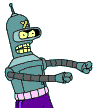Remove Recycle Bin Icon from Desktop
Are you a “shift-deleter”? Well I am. Most of my deleted files are not going to Recycle Bin because I use shift+delete operation to permanently delete them. In this case, the Recycle Bin icon from the [url="http://news.softpedia.com/news/Shell-Related-Widows-Tricks-42556.shtml#"]desktop[/url] is kind of obsolete. If you ever tried to delete it you may have noticed that you can do it using the universal method. It has no delete option when right clicking it. So what do we do? There is a method: editing the [url="http://news.softpedia.com/news/Shell-Related-Widows-Tricks-42556.shtml#"]registry[/url]:
Go to Start -> run -> type Regedit. In the Registry Editor window search the fallow the path: HKEY_LOCAL_MACHINE/SOFTWARE/Microsoft/Windows/CurrentVersion/explorer/Desktop/NameSpace. Once you have found the Recycle Bin string, just delete it and you are done; the trash icon is no more on your desktop.
Renaming the Recycle Bin
If we talked about removing the Recycle Bin from the desktop let’s see how to rename this fellow. Normally, there is no option available for the user to do this operation although many of you want to name it according to your desires. To do it we need to edit the registry the same way we performed in the precedent operation mentioned above.
So, go to Start->run-> type Regedit and look for this path: HKEY_CLASSES_ROOT/CLSID/{645FF040-5081-101B-9F08-00AA002F954E}. There you can find the Recycle Bin. Just delete the name between the quotes and enter the desired name.
How to enable Hibernation Button
The hibernation button (common in the previous Windows versions), was available in the Shut Down menu. Because now, in Windows [url="http://news.softpedia.com/news/Shell-Related-Widows-Tricks-42556.shtml#"]XP[/url] it’s not generally available ([url="http://news.softpedia.com/news/Shell-Related-Widows-Tricks-42556.shtml#"]motherboard[/url] issues), you might miss it a lot. That’s why here is the simplest method to activate the Hibernation button:
Go to Start -> Turn Off [url="http://news.softpedia.com/news/Shell-Related-Widows-Tricks-42556.shtml#"]Computer[/url] -> hold the Shift key and the Stand By button will morph into Hibernate button. To enter hibernate mode keep the shift key pressed and click the new button. All the content of the RAM will be saved on [url="http://news.softpedia.com/news/Shell-Related-Widows-Tricks-42556.shtml#"]disk[/url] and you can continue your work after you power on the computer from the same point.
Fast Access Volume Control Shortcut
Ever wanted to adjust the volume but, because Windows hides unused tray icons, you found it difficult to perform? Placing the volume icon on the desktop offers fast [url="http://news.softpedia.com/news/Shell-Related-Widows-Tricks-42556.shtml#"]access[/url] to your sounds settings.
Right click on your desktop and choose New -> Shortcut and in the provided field type sndvol32.exe. Name it and click ok. The volume control icon will appear.
Train “My Computer” to open in Explorer Mode
Did you know that My Computer can start in the explorer mode? If not here are the steps that must be proceeded to teach “My Computer” start in the explorer mode.
Open My Computer and go to Tools -> Folder Options -> File Types. Here go to (NONE) Folders and select it. After you have selected it click Advanced. In this window you have two actions available: explore and open. The “open” action is in bold. This means it is set by default. Select the “explorer” action and click “Set as default”. Now My Computer will open in explorer mode.
Permanently delete the arrow from shortcuts
Shortcuts under Windows are adorned by default with a distinctive arrow to specially inform us that we are dealing with a shortcut, not with the [url="http://news.softpedia.com/news/Shell-Related-Widows-Tricks-42556.shtml#"]application[/url] itself. While on the desktop we keep most of out shortcuts, not applications files, the arrow is annoying. Because there is no option to remove the arrow from the shortcuts here is a trick how to do it:
Go to Start -> Run -> Type Regedit. Browse the registry tree and look for HKEY_CLASSES_ROOT – lnkfile. Once you got there just delete the IsShortcut key. Now restart or log off computer and the icons will appear with no arrow attached.
How to remove the shared documents folder from My Computer
Have you noticed that when you open My Computer in the list there is a “Shared Documents” folder right on top? This folder cannot be deleted the way you do with a regular folder. Let’s get rid of it!
Go to Start -> Run -> Type Regedit. Browse to HKEY_LOCAL_MACHINE [url="http://news.softpedia.com/news/Shell-Related-Widows-Tricks-42556.shtml#"]SOFTWARE[/url] [url="http://news.softpedia.com/news/Shell-Related-Widows-Tricks-42556.shtml#"]Microsoft Windows[/url] CurrentVersion Explorer My Computer NameSpace DelegateFolders and delete the fallowing sub-key: {59031a47-3f72-44a7-89c5-5595fe6b30ee} Restart computer and you are done.
Set a permanent view for your files and folders
The file view in Windows can be customized using 5 patterns: thumbnails, tiles, icons, list and details. I personally prefer the list view because it offers me the largest option to [url="http://news.softpedia.com/news/Shell-Related-Widows-Tricks-42556.shtml#"]monitor[/url] all my files and folders. You may prefer some other view option, but how do we set it up by default for all the files and folders. To stick with just one view option open My Computer, go to File Options -> View and uncheck “Remember each folder’s view settings”. Now Windows will remember only the last view option selected and will apply it to all your files
XP minor tricks...check dis out....
1 post
• Page 1 of 1
XP minor tricks...check dis out....
TR Anthem Video. View Here
IntenZe First Video
IntenZe First Video
-

C-Game - Band Leader

- Posts: 7930
- Joined: Jul 24th, '06, 19:02
- Location: THRONE of the KING OF KINGS
- Gender: Male
1 post
• Page 1 of 1
Return to Computing & Technology
Who is online
Users browsing this forum: No registered users
